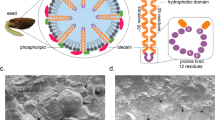Abstract.
In order to clarify further the physiological role of oleosins in seed development, we characterized the oil-body proteins of several oilseeds exhibiting a range of desiccation sensitivities from the recalcitrant (Theobroma cacao L., Quercus rubra L.), intermediate (Coffea arabica L., Azadirachta indica A. Juss.) and orthodox categories (Sterculia setigera Del., Brassica napus L.). The estimated ratio of putative oleosins to lipid in oil bodies of Q. rubra was less than 5% of the equivalent values for rapeseed oil bodies. No oleosin was detected in T. cacao oil bodies. In A. indica cotyledons, oil bodies contained very low amounts of putative oleosins. Oil bodies both from C. arabica and S. setigera exhibited a similar ratio of putative oleosins to lipid as found in rapeseed. In C. arabica seeds, the central domain of an oleosin was partially sequenced. Using a low temperature field-emission scanning electron microscope, the structural stability of oil bodies was investigated in seeds after drying, storage in cold conditions and rehydration. Despite the absence or relative dearth of oleosins in desiccation-sensitive, recalcitrant oilseeds, oil bodies remained relatively stable after slow or fast drying. In A. indica seeds exposed to a lethal cold storage treatment, no significant change in oil-body sizes was observed. In contrast, during imbibition of artificially dried seeds containing low amounts of putative oleosins, the oil bodies fused to form large droplets, resulting in the loss of cellular integrity. No damage to the oil bodies occurred in imbibed seeds of Q. rubra, C. arabica and S. setigera. Thus the rehydration phase appears to be detrimental to the stability of oil bodies when these are present in large amounts and are lacking oleosins. We therefore suggest that one of the functions of oleosins in oilseed development may be to stabilize oil bodies during seed imbibition prior to germination.
Similar content being viewed by others
Author information
Authors and Affiliations
Additional information
Received: 22 April 1997 / Accepted: 5 June 1997
Rights and permissions
About this article
Cite this article
Leprince, O., van Aelst, A., Pritchard, H. et al. Oleosins prevent oil-body coalescence during seed imbibition as suggested by a low-temperature scanning electron microscope study of desiccation-tolerant and -sensitive oilseeds. Planta 204, 109–119 (1997). https://doi.org/10.1007/s004250050236
Issue Date:
DOI: https://doi.org/10.1007/s004250050236




